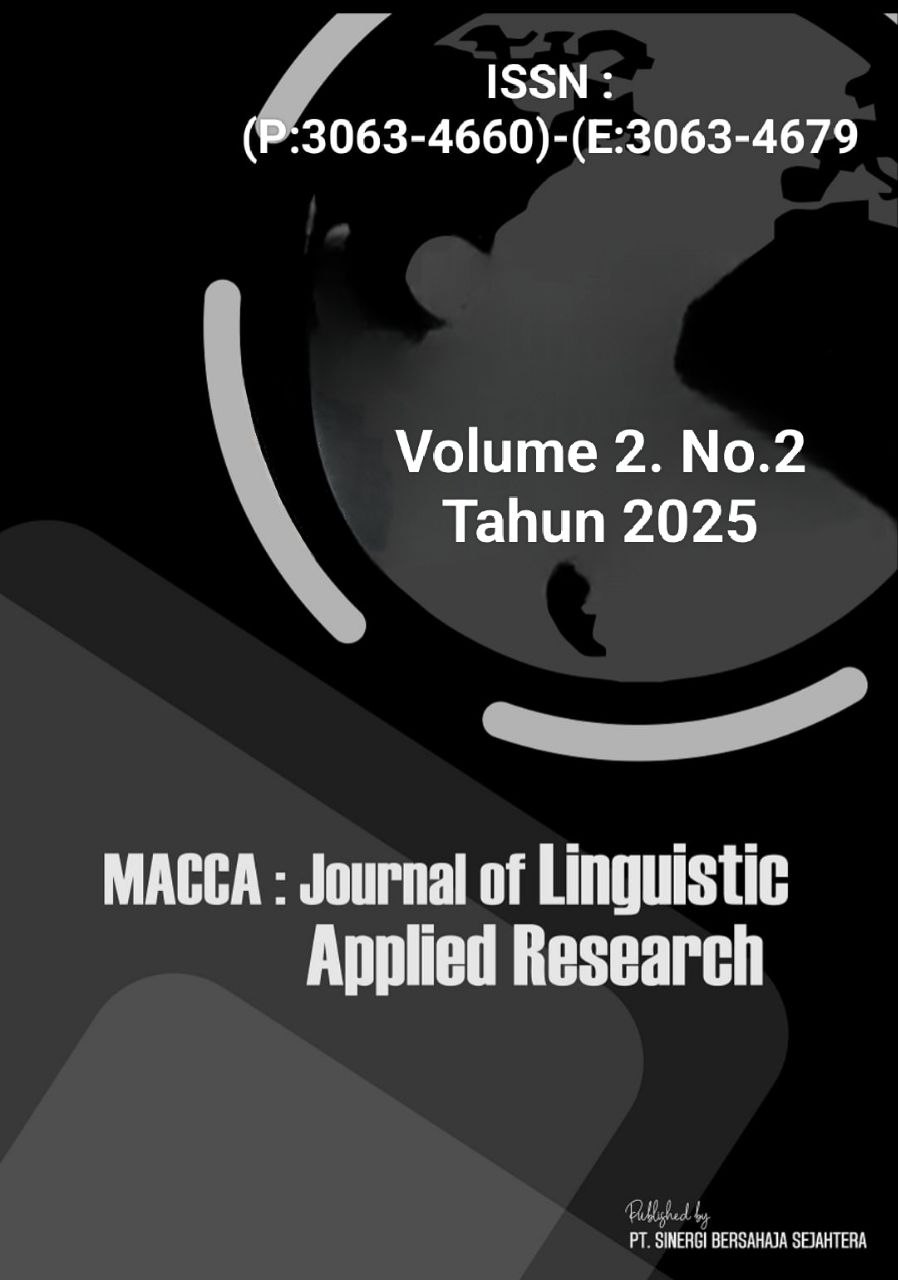The Effect Of English Film On Students Listening Comprehension Skills
Keywords:
English-language films, listening comprehension, EFL students, motivation, qualitative studyAbstract
This study investigates the effect of English-language films on students’ listening comprehension skills at SMAN 2 Sidrap. The research was motivated by the challenges students face in understanding authentic spoken English, including varied accents, speech rates, and idiomatic expressions. Using a qualitative descriptive case study design, data were collected through observation sheets, semi-structured interviews, and listening comprehension tests administered to 20 eleventh-grade students before and after watching the film The Wild Robot.
The findings revealed significant improvements in students’ listening comprehension. After the intervention, students demonstrated better understanding of spoken English, reduced difficulties with accents and fast speech, and an enriched vocabulary. Moreover, their motivation to learn and confidence in listening without subtitles increased notably. The majority of students (90%) described the experience as enjoyable and effective, highlighting films as a meaningful and engaging medium for language learning.
This research concludes that English-language films can effectively enhance listening comprehension by providing authentic linguistic input, cultural context, and engaging audiovisual support. Teachers are encouraged to integrate films into classroom activities as a creative strategy to improve students’ listening skills, while students are recommended to continue watching English films independently to reinforce their learning.
References
Baddeley, A. D. (2003). Working memory and language. In M. J. Spivey, K. McRae, & M. E. Peterson (Eds.), The Cambridge handbook of psycholinguistics. Cambridge University Press.
Bordwell, D., & Thompson, K. (2004). Film art: An introduction. McGraw-Hill.
Braun, V., & Clarke, V. (2006). Using thematic analysis in psychology. Qualitative Research in Psychology, 3(2), 77–101.
Brown, H. D. (2007). Principles of language learning and teaching (5th ed.). Pearson Education.
Byram, M. (1997). Teaching and assessing intercultural communicative competence. Multilingual Matters.
Creswell, J. W. (2014). Research design: Qualitative, quantitative, and mixed methods approaches (4th ed.). SAGE Publications.
Dixon, W. W. (2005). Film history: A critical introduction. McGraw-Hill.
Field, J. (2003). Listening in the language classroom. Cambridge University Press.
Girotto, V. (2014). The use of movies in the EFL classroom: A study on the effectiveness of using films in the teaching of English as a foreign language. International Journal of English Language Teaching, 2(2), 13–23.
Hughes, D. (2007). The history of British cinema. BFI Publishing.
Kemmis, S., & McTaggart, R. (1988). The action research planner. Deakin University Press.
Kuo, H. C., & Lai, C. W. (2020). The effectiveness of movies for learning English vocabulary: A meta-analysis of studies. Journal of Language Teaching and Research, 11(5), 675–683.
Kusumawati, R. (2018). The effect of watching English movies on students’ vocabulary mastery: A study of junior high school students in Yogyakarta. Indonesian Journal of English Language Teaching, 4(1), 45–56.
Lury, C. (2004). Globalization and the media. Polity Press.
Moleong, L. J. (2017). Metodologi penelitian kualitatif. PT Remaja Rosdakarya.
Nation, P. (2001). Learning vocabulary in another language. Cambridge University Press.
Neale, S. (2000). Genre and Hollywood. Routledge.
Nunan, D. (2003). Practical English language teaching. McGraw-Hill.
O’Malley, J. M., & Chamot, A. U. (1990). Learning strategies in second language acquisition. Cambridge University Press.
Rao, P. S. (2019). Listening comprehension: Factors affecting listening skills. International Journal of Advanced Research in English, 6(3), 1–9.
Riska Wati, Sam Hermansyah, Isumarni, & Sitti Aisa. (2025). The analysis of students’ interest In learn English of SMPN 6 Satap Baraka. Macca: Journal of Linguistic Applied Research, 2(1). Retrieved from https://journal.adityarifqisam.org/index.php/macca/article/view/150
Rost, M. (2002). Teaching and researching listening. Pearson Education.
Roy, Andi Sadapotto, Sitti Aisa, & Sam Hermansyah. (2025). Investigating The Effect Of Flashcard Towards Efl Learns Vocabulary Mastery At SMP 2 Batu Satap Leppangeng. Macca: Journal of Linguistic Applied Research, 2(2). Retrieved from https://journal.adityarifqisam.org/index.php/macca/article/view/183
S, D., Joanna Finny, M., M, D. N., & Hermansyah, D. S. (2025). THE KNOWLEDGE CONTINUUM: LITERATURE-BASED STUDY AS A RESEARCH TOOL IN SOCIAL SCIENCES. La Ogi : English Language Journal, 11(2), 133-143. https://doi.org/10.55678/loj.v11i2.2262
Sam Hermansyah, & Ahmad Rizal Majid. (2025). The Use of Probing-Prompting Technique to Improve Reading Comprehension of Eighth Grade Students. INTERACTION: Jurnal Pendidikan Bahasa, 12(1), 543–556. https://doi.org/10.36232/interactionjournal.v12i1.2660
Sari, D. (2021). Film as a tool for improving students’ English comprehension: An exploration in senior high school context. Journal of English Language Teaching, 12(3), 220–228.
Schatz, T. (1981). Hollywood genres: Formulas, filmmaking, and the studio system. Random House.
Suvorov, R. (2012). Listening comprehension: A review of the literature. Journal of Language Teaching and Research, 3(6), 1303–1309.
Hermansyah, S., & Hasan, H. (2020). Exploring the impact of English movies to improve the students’ listening comprehension. Journal of English Education, 2(2), 32–36.
Tavakoli, M., & Rezazadeh, M. (2017). The impact of using movies on English language learners’ vocabulary acquisition and comprehension skills. Journal of Language Teaching and Research, 8(4), 780–788.
Ur, P. (1984). Teaching listening comprehension. Cambridge University Press.
Vandergrift, L. (2004). Listening to learn or learning to listen? Annual Review of Applied Linguistics, 24, 3–25.
Wright, A. (2011). Listening, speaking, and watching movies: Using film in the ESL/EFL classroom. Cambridge University Press.
Yin, R. K. (2018). Case study research and applications: Design and methods (6th ed.). SAGE Publications.
Downloads
Published
How to Cite
Issue
Section
License
Copyright (c) 2025 SABRINA PRABOWO, Sam Hermansyah, Buhari, Nur hikmah

This work is licensed under a Creative Commons Attribution-ShareAlike 4.0 International License.



































